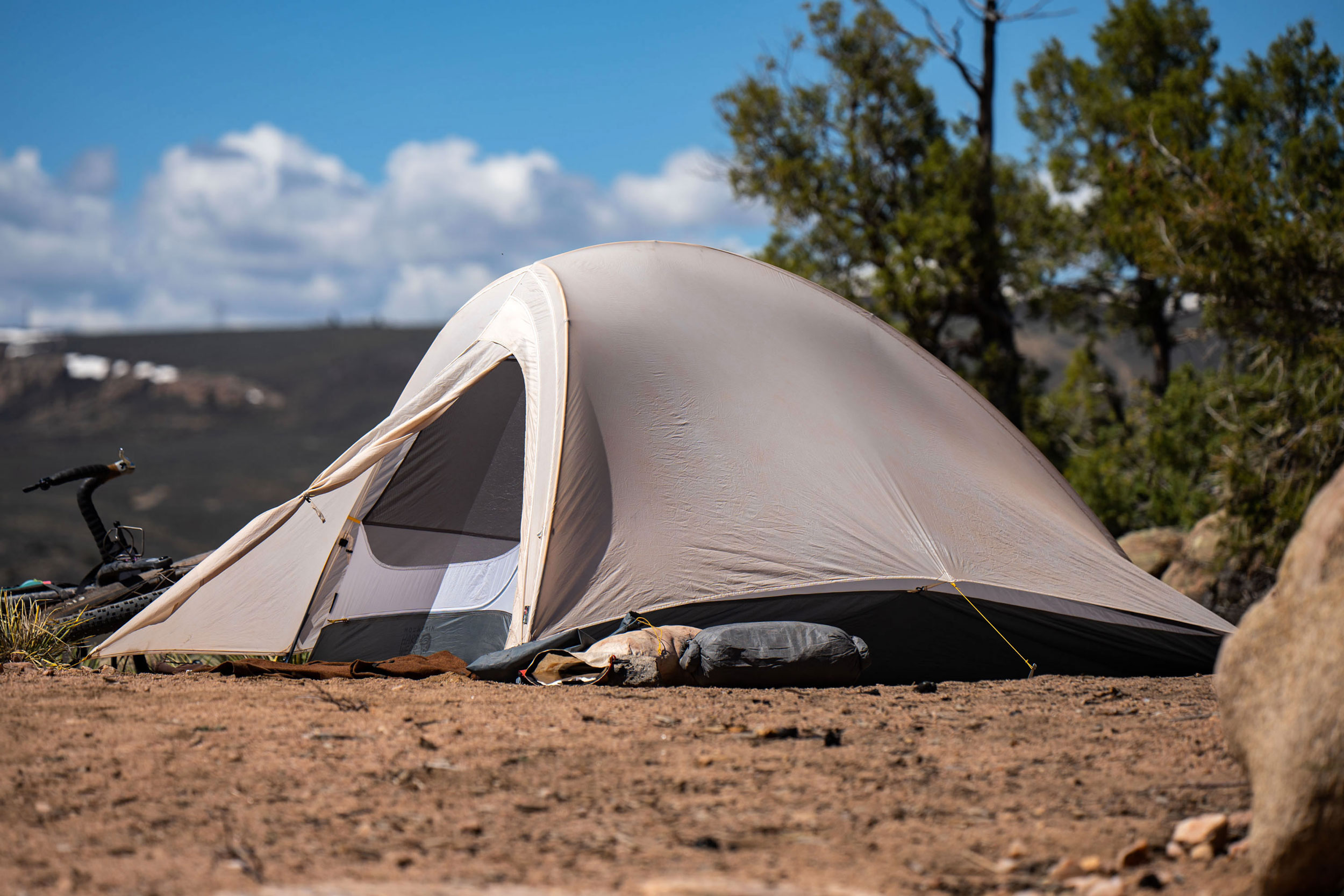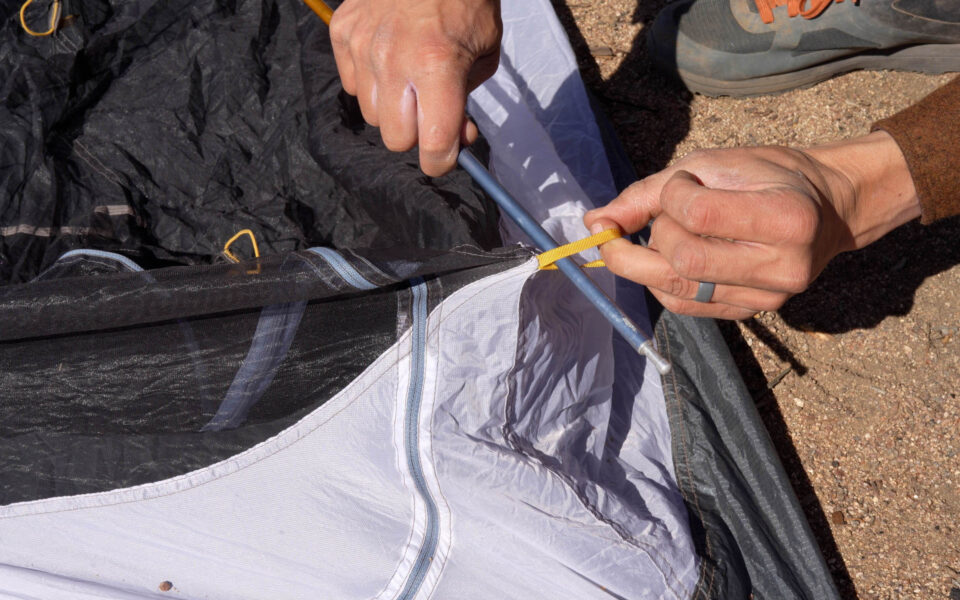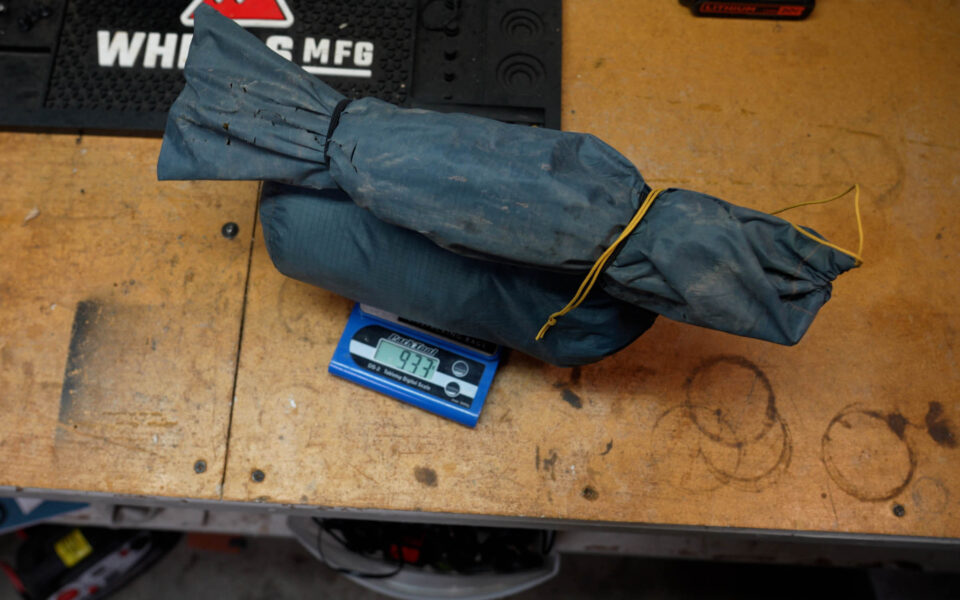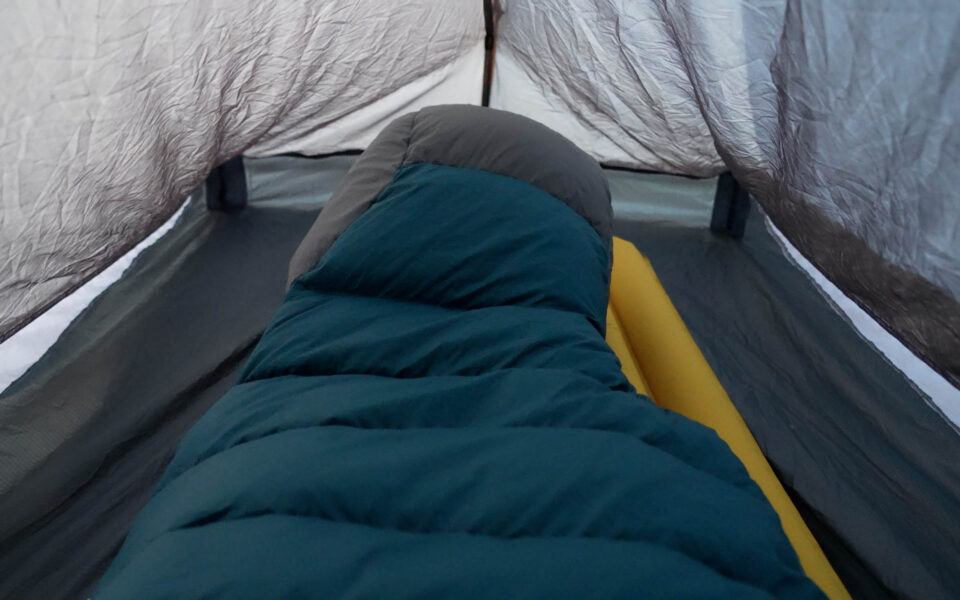Mountain Hardwear Nimbus UL1 Tent Review
Key factors to consider in a bikepacking-worthy tent are packability, durability, and how well it can withstand the elements, all while being a comfortable place to hang out and sleep for extended periods. Neil found a good balance of all those things in the Mountain Hardwear Nimbus UL1, and in our latest video, he shares his experience with the brand’s lightest tent offering. Find that plus a comparison with eight other double-wall one-person tents here…
While bikepacking, a tent is your home away from home and a pretty important piece of kit. For solo bikepackers, the most popular type of tent is the double-wall one-person tent, which is also the most common type of shelter use across other outdoor pursuits. The obvious considerations when choosing a tent are its packability, durability, and how well it can withstand the elements, all while being a comfortable place to be in for a long period of time. Neil found that the Mountain Hardwear Nimbus UL1 Tent ticked all those boxes. Find his detailed review here and then scroll down for a comparison with other double-wall one-person tents.
The tent is 100% nylon with a 30D ripstop floor that comes up a few inches on the sides, a 15D Silnylon white body, and a 15D 15d Mesh nylon. The fly of the tent is made of 20D Silnylon and also comes with a dual-zipper, single-door design to fit with the body. Generally speaking, Mountain Hardwear maximized their strength where they needed it and reduced it where they didn’t. This is a common method in tent making.
The tent has a footprint of 86″ (218 cm) in length, with a 38″ (96.5 cm) width at the head of the tent and a 28” (71 cm) width at the foot. The tent fly adds an additional vestibule space of 28″ (71 cm) from the tent body that tapers to the corner of the head of the tent. At 5′ 9.5″ (177cm), I had plenty of extra room at both the foot and head of my tent. The tent also has a height of 38” (96.5 cm) from the ground to the highest point of the tent, providing enough room to sit up. That said, if you’re a tall person who moves around a lot at night, you might find yourself at the top or the bottom of the tent. It’s worth noting that you could easily mistake the Nimbus UL1 for the Big Agnes Fly Creek, as the only real difference in dimensions is a little extra head space on the Fly Creek.
The tent is designed around a three-point wishbone frame made from pre-bent DAC featherweight NFL poles that weigh 215 grams and are 38 centimeters long. They come with a repair splint in case a pole cracks or breaks. The tent has eight 7-gram stakes that proved to be very durable after number of rock strikes. You can also get an additional 40D ground cloth, but I decided against that as this tent can’t be used in fast-fly mode (with just the fly and ground cloth), plus ground cloths are extra money and weight. If you ever want a ground cloth and want to save some money, just purchase some Tyvek or bug a contractor down the street.
Mountain Hardwear Nimbus UL1 Compared
The three season, front-entry Nimbus came in at 2 pounds even (933 grams), including stuff sacks, poles, stakes, guy lines, tent body, and a fly that’s a little dirty. It’s not the lightest tent out there—as you can see in the comparison chart below—but it holds its own in the category of semi free-standing, double-wall tents.
The Nimbus 1 also comes in at a pretty decent price point for a tent of this nature. To put things in perspective, the Big Agnes Fly Creek comes in at $370 with a full mesh body. And the Nemo Hornet Osmo comes in at $400. Dig into the the list of one-person double-wall tents with prices, weights, and flow measurements below.
| Tent Brand and Model | Floor (LxW) | Weight | Price |
|---|---|---|---|
| Mountain Hardwear Nimbus UL1 |
86×38/28″
218×97/71cm
|
2 lbs
933 g
|
$400 |
| Big Agnes Fly Creek UL1 |
86×38/28″
218×97/71cm
|
2 lb
907 g
|
$370 |
| Big Agnes Coppr Spur UL1 |
88×38/28″
224×97/71cm
|
2 lb 6 oz
1.08 kg
|
$449 |
| Big Agnes Tiger Wall UL1 |
84×38/28″
213×97/71cm
|
2 lb 2 oz
652 g
|
$400 |
| Nemo Dragonfly Osmo UL1 |
88×35/32″
224×89/80cm
|
2 lb 10 oz
1.2 kg
|
$430 |
| Nemo Dragonfly Osmo UL1 Bikepack |
88×35/32″
224×89/80cm
|
2 lb 11 oz
1.2 kg
|
$520 |
| Nemo Hornet Osmo UL1 |
87×43/31″
222×108/79cm
|
2 lb 4 oz
1.0 kg
|
$400 |
| Nemo Hornet Elite Osmo UL1 |
87×40/32″
221×102/81cm
|
1 lb 13 oz
812 g
|
$550 |
| MSR Freelite 1p |
87×33″
221x84cm
|
1 lb 15 oz
890 g
|
$420 |
| MSR Hubba Hubba 1p |
85×30″
216x76cm
|
2 lbs 7 oz
1.1 kg
|
$470 |
Set up
The set up of this tent is pretty easy. You start by staking or tying down the four corners of the tent and attaching the poles to three color-coded aluminum pole attachment points that are a part of the body of the tent. Start with the front because you need to loop the two poles through some webbing loops, which might be the Nimbus’ most significant design flaw. The rest of the attachments use a G-Hook canopy-to-pole attachment system which Mountain Hardwear says helps compressibility versus the larger clip system found on competing tents. I didn’t mind the G-hooks; the system worked well and was easy to attach and uninstall, and the tent body never detached from the G-hooks unexpectedly. It’s a unique design, which I always appreciate.
While the tent doesn’t need to be used with the fly, I found myself using the fly most of the time in cooler temps. The fly easily attaches to the three aluminum pole attachment points and the two tent stakes at the foot of the tent, and it tightens with a compression cord at all three pole points. The fly also comes with three more stake attachment points if you need them. At the sides of the fly are two clips to attach to the body of the tent that stretch out the tent a bit more for space. The tent fly also comes with velcro straps to attach to the tent poles, and while I used them, I’m not sure how useful they really are. The provided guy lines paired with the fly aren’t entirely necessary, but I found the extra cord to be useful in the event I needed some extra length when I was using rocks as tent anchors.
Overall, the set up was straightforward. However, with the nylon fly there is some stretching that occurs with temperature and humidity fluctuations. I found that I’d set up the tent when I got to camp, then adjust the fly before going to bed for the night, just to ensure it was ready for any wind or rain in the night. This is normal and comes with the territory when using a nylon tent.
In use
Packing this thing down was exceptionally easy. It takes no time at all, and from time to time, I even used the provided stuff sack, especially when using the Tailfin AeroPack, as it helped keep the tent contained for an additional 15 grams. But, when using a seat pack or dry bag, I would just shove it in and compress it down and leave the stuff sack at home.
As for the poles, they aren’t short like those from some companies adopting shorter bikepacking-specific poles, but I never truly found this to be annoying, and I think the longer poles worked in my favor more so as I typically packed them with the provided pole bag and strapped them next to my dry bag on a rear rack. But, I could see this being an issue if you want to install them on a narrower handlebar or if you want to fit them in a framebag that has limited space. After inspecting the poles, there are no dents or bends, just a bunch of scrapes and scratches. The tent also comes with a small stake bag, which is nice to keep the stakes and extra guy lines in order.
My time inside
The inside of the Mountain Hardwear Nimbus UL1 was cozy but still offered plenty of room for me, even as a side sleeper who moves around at night. The Nimbus has two pockets inside: a side pocket where I usually put the stuff sacks for the tent (sleeping pad, and other smaller items that could easily fit) and a pocket on the top of the mesh for other items. I used this from time to time, for lighter items, or my head lamp, but I usually put things in dry bags in the vestibule to free up space.
The tent did a great job of keeping bugs out, and the mesh shows no real signs of significant wear in any area. One thing I appreciate about the added nylon near the head is a bit of wind protection but also protection from flying debris such as sand. It does a decent job of reducing the sand entering the tent near my head, as opposed to a tent with a full mesh body.
The tent endured a lot of wind and rain during the testing period. It survived gusty winds up to around 30 miles per hour, however, the foot of the tent is a little less stable in high wind due to the three-point pole frame. I woke up in the middle of the night on a recent trip, and it was very windy. I went outside to make sure my rock stakes were intact. They were, but this was a serious test of the Nimbus, which it passed despite the side of the tent acting as a sail of sorts. All of the reinforced seams and anchors held fast; however, the tent fly now has a hint of orange from Moab sandstone pelting the side of it.
As for rain, I had to sit in the Nimbus for a full evening, all night, and the morning during heavy rain in Wisconsin. I even set it up in the rain. The base of the tent did a pretty good job of keeping the moisture out, but a sheet of Tyvek could have kept the floor from getting a little damp. One wish is that the side of the fly would be maybe an extra foot long, as the current height allows wind to pick up moisture or unwanted sand and deposit it under the fly. That said, even when the fly was saturated, there was still enough of a gap between the mesh and the fly to prevent water from entering the mesh.

The Nimbus’ lightweight nylon does a great job of drying out, especially in the desert West. Once the sun popped out, any bit of condensation was gone, and the tent itself never really seemed to build up too much moisture, even during cold nights. But, again, most of my time testing this tent was in the Western United States, which tends to be less humid.
Pros
- Lightweight and compact design
- Fast and easy to setup
- Roomy interior, all things considered
- Quality stakes
- Body and mesh have proven to be durable
- Reliable option for most three-season applications
Cons
- Front poles each thread though webbing straps, which is a little tedious
- Rain fly stretches with moisture
- Rain fly has poor coverage at tent base
- Only one color option; not ideal for stealth camping
- Model Tested: Mountain Hardwear Nimbus UL1 Tent
- Actual Weight: 933 grams
- Price: $400 at REI
- Manufacturer’s Details: MountainHardwear.com
Final Thoughts
I started testing the Mountain Hardwear Nimbus UL1 tent a year ago and have found it to be a solid, lightweight, packable, minimal-frills tent that’s reliable in the elements. It’s endured a handful of trips over the year, and it became a reliable place to get some shut eye, even if conditions were not so pleasant. The fly has seen some abuse, but the body and overall functionality is still there.
Please keep the conversation civil, constructive, and inclusive, or your comment will be removed.








































